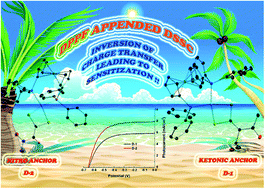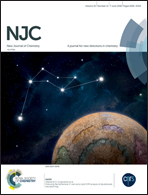1,1′-Bis(diphenylphosphino)ferrocene-appended nickel(ii) dithiolates as sensitizers in dye-sensitized solar cells†
Abstract
Herein, two new Ni(dppf)dithiolates in which dithiolate ligands comprise 2,2-diacetyl (D-1) and 2-nitro (D-2) anchors have been synthesized and characterized using microanalyses, FTIR, 1H and 13C NMR spectroscopy, as well as single-crystal X-ray diffraction. The X-ray crystallographic studies indicate that in both compounds, the geometry around the Ni(II) center can be described as distorted square planar, which is defined by the two sulfur centers of the dinegative dithiolate ligands and two phosphorus centers of the neutral dppf ligand. The electronic absorption spectra for both sensitizers display a blue shift when compared with the characteristic electronic absorption spectrum of the dppf ligand in a similar wavelength region. The photovoltaic performances and charge transport properties (EIS spectra) were studied to evaluate the performance of the synthesized dye in DSSCs. Upon comparing both dyes, it was found that the dye with the nitro anchor (D-2) showed better photovoltaic performance than the dye with the ketonic anchor (D-1). The superior performance of D-2 suggests better anchorage and superior dye loading capability on the TiO2 surface, which suppresses charge recombination, prolongs electron lifetime, and decreases the total resistance of DSSCs. The assembly fabricated using D-2 showed best performance with an overall conversion efficiency, η, of 3.21%, Jsc of 7.96 mA cm−2, and Voc of −0.654 V. The obtained efficiency is ∼46% that of today's state-of-the-art N719 dye under similar conditions. The probable reasons for the poor performance of both dyes have been addressed with the help of theoretical calculations.



 Please wait while we load your content...
Please wait while we load your content...